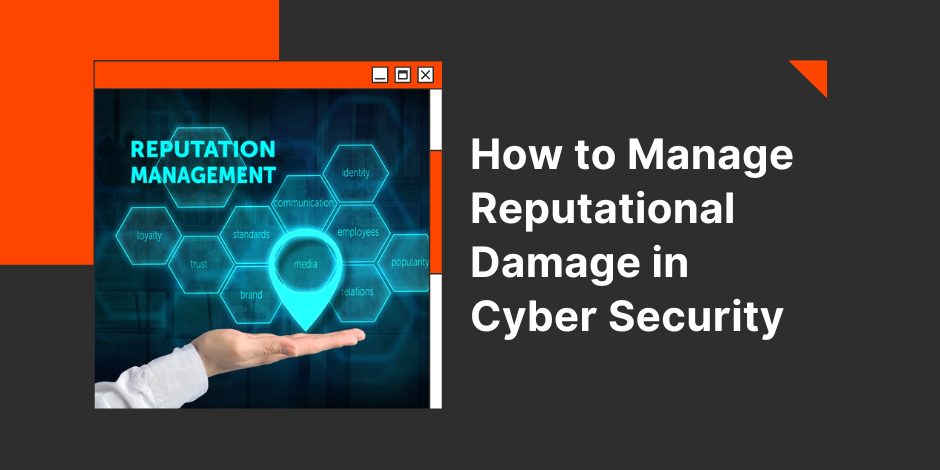How to Manage Reputational Damage in Cyber Security

Stay Informed With Our Weekly Newsletter
Receive crucial updates on the ever-evolving landscape of technology and innovation.
The concept of reputational damage in cyber security is a critical consideration for companies operating in the digital age.
With the increasing sophistication of cyberattacks, organisations are constantly at risk of suffering reputational damage due to data breaches and other cyber security incidents.
Understanding the concept of reputational damage in cyber security

Reputational damage refers to the negative impact on a company’s reputation that can result from a cyber security incident.
Cyberattacks can expose sensitive customer data, disrupt business operations, and erode consumer trust. This can lead to losing customers, revenue, and a tarnished reputation.
The impact of cyberattacks on a company’s reputation
Cyberattacks can have far-reaching consequences for a company’s reputation.
When a breach occurs, news spreads quickly, causing widespread panic among customers, investors, and other stakeholders.
The negative publicity generated by a cyberattack can tarnish a company’s image and credibility, making it challenging to regain consumers’ trust.
The financial implications of reputational damage can be severe. Companies may face costly legal actions, regulatory fines, and the need to invest in additional cyber security measures to prevent future incidents.
Ultimately, reputational damage in cyber security can extend beyond the immediate aftermath, affecting a company’s competitiveness and long-term viability.
The relationship between data breaches and public perception
Data breaches have become increasingly prevalent in today’s digital landscape, with cyber criminals targeting large and small organisations.
When sensitive customer data is compromised, public perception of a company can be significantly affected.
Customers may question the company’s ability to protect their personal information, leading to a loss of trust and a potential exodus of loyal customers.
Companies must be proactive in their approach to cyber security. This involves implementing robust security measures, regularly updating software and systems, and conducting thorough risk assessments.
By taking a proactive stance, companies can reduce the likelihood of a cyberattack and mitigate the potential impact on their reputation.
The role of effective communication in damage control
Effective communication is crucial in managing reputational damage in cyber security.
Transparent, timely, and accurate communication can help mitigate a breach’s impact and rebuild stakeholder trust.
Communicating a cyber security incident to stakeholders
When a cyber security incident occurs, companies must communicate promptly with all relevant stakeholders, including customers, employees, investors, and regulators.
This communication should be concise and provide accurate information about the incident, its impact, and the steps to address it.
Transparency is paramount in these communications. Companies should acknowledge any shortcomings or vulnerabilities that may have contributed to the breach and outline the steps to prevent future incidents.
Companies can demonstrate their commitment to addressing the issue and rebuilding trust by being open and honest.
The importance of transparency in managing reputational damage
Transparency is a critical factor in managing reputational damage effectively.
After a cyberattack, companies should be proactive in providing updates and addressing concerns from stakeholders.
Update on the progress of the investigation, the steps taken to mitigate the breach’s impact, and any changes being made to prevent future incidents.
By being transparent, companies can instil confidence in their stakeholders and demonstrate their commitment to resolving the issue.
Implementing proactive measures to protect your company’s reputation

Prevention is always better than cure when managing reputational damage in cyber security.
By taking proactive measures to protect your company’s reputation, you can reduce the likelihood of a cyberattack and mitigate the impact on your organisation.
Building a robust cyber security framework
A robust cyber security framework is vital for protecting your company’s reputation.
This framework should include a combination of technical controls, procedures, and policies, as well as employee training to ensure a comprehensive approach to cyber security.
Technical controls may include firewalls, intrusion detection systems, and data encryption to safeguard against external threats.
Policies and procedures should outline best practices for data protection, incident response, and employee responsibilities.
Regular staff training and awareness programs should also be conducted to ensure employees have the skills and knowledge to identify and respond to cyber threats.
Regular staff training and awareness programs
Employees are often the first line of defence against cyberattacks.
Regular staff training and awareness programs are essential for keeping employees informed about the latest cyber threats and ensuring they understand their role in protecting company data and preserving its reputation.
Training should cover phishing attacks, password security, and reporting suspicious activities.
By educating and empowering employees, companies can create a culture of cyber security awareness and reduce the risk of reputational damage.
Responding to a cyber security incident
Despite best efforts, it is still possible for a cyber security incident to occur.
In such cases, having a well-defined incident response plan is crucial to minimise the impact on your company’s reputation.
The role of a cyber incident response team
A cyber incident response team is critical in effectively managing a cyber security incident.
This team should consist of individuals with cyber security, legal and compliance, public relations, and IT expertise.
Their collective knowledge and skills can help to contain the incident, investigate the breach, and coordinate communication with stakeholders.
Steps to take following a data breach
Following a data breach, an organisation must take swift action to contain the incident and minimise reputational damage.
This involves isolating affected systems, collecting evidence for forensic analysis, and notifying the appropriate authorities and affected individuals.
In addition to these technical steps, it is crucial to communicate with stakeholders promptly and transparently.
This includes informing customers about the incident, the potential impact on their data, and the actions to address the breach.
Companies should also offer support and resources to affected individuals, such as credit monitoring or identity theft protection services.
Recovering from reputational damage in cyber security

Recovering from reputational damage in cyber security is challenging and requires a strategic and long-term approach.
It is essential to acknowledge that rebuilding trust and restoring a company’s reputation takes time and effort.
Rebuilding trust after a cyber security incident
After experiencing reputational damage due to a cyber security incident, companies must proactively rebuild trust with their stakeholders.
This includes demonstrating a sincere commitment to improving cyber security practices, implementing more robust security measures, and regularly communicating updates on progress and lessons learned.
Transparency is vital during the recovery process, as it helps to reassure stakeholders that the company is taking the necessary steps to prevent future incidents and protect their data.
Regular communication and engagement with stakeholders will help to rebuild trust and demonstrate that the company has learned from its mistakes.
Long-term strategies for reputation management in cyber security
Managing reputational damage in cyber security requires a long-term commitment to proactive measures and ongoing improvement.
Companies should continually evaluate and update their cyber security practices to stay ahead of evolving threats and minimise the risk of future incidents.
Additionally, companies should leverage the expertise of external consultants or security agencies to conduct regular security audits and penetration tests.
These assessments can help identify vulnerabilities and recommend strengthening cyber security measures.
Conclusion
Managing reputational damage in cyber security is a complex and ongoing challenge for companies.
By understanding the concept of reputational damage, implementing proactive measures, and responding effectively to cyber security incidents, companies can protect their reputation, rebuild trust, and maintain a strong position in the digital landscape.
Considering a career in cyber security?
By choosing the Institute of Data’s Cyber Security program, you’ll be equipped with the skills and expertise to navigate today’s digital threats.
With the rise of cyber incidents, there’s never been a more crucial time to be at the forefront of this ever-evolving field.
Ready to discuss your learning options? Contact our local team for a free career consultation.




